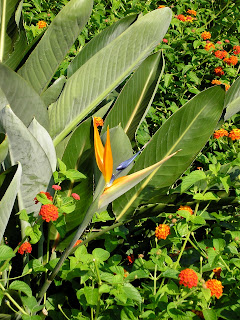An ornamental canna (Canna spp.) at the southeastern corner of the intersection of 12th Street and Jefferson Drive SW, just to the northeast of the Freer Gallery on the Mall in Washington. For more on canna, see this very informative Wikipedia entry.
A closer look at the canna's flowers. Cannas are now widely used in Washington gardens and landscapings.
A gorgeous Bird of Paradise plant (Strelitzia reginae) in the landscaping at the northern entrance to the Freer Gallery. Read more at this Wikipedia entry.
Another Bird of Paradise flowering in this same location.
And there is also one blooming in the collection of tropical plants in the Smithsonian's Enid A. Haupt Garden, immediately east of the Freer Gallery.
A very funky tree growing near the northwestern entrance to the Enid Haupt Gardens, right up against the southern facade of the Smithsonian Castle. This is a young monkey puzzle tree (Araucaria araucana), a native of the dry highlands of Chile and Argentina. See more at this Wikipedia entry.
A closer look at its foliage, which consists of triangular, very sharp and leathery leaves set directly in the stem - an adaptation designed to deal with an arid environment.
An ornamental Angel's Trumpet (Brugmansi spp.) growing at the center of the Enid Haupt Garden's tropical collection. See this Wikipedia entry.
A closer look at the Angel's Trumpet's large hanging flowers. This plant is a member of the nightshade family and thus distantly related to tomatoes and potatoes.
Another truly wild plant from the tropical collection - the Bismarck Palm (Bismarckia nobilis), a native of the northern Madagascar highlands. Each entire splay of spikes, looking like the display of a peacock, is a single humongous leaf. Learn more at this Wikipedia entry.
A gold finger plant (Juanulloa aurantiaca), a native of Mexico. No Wikipedia entry on this one, but see this page from a tropical garden center.
A Buddha's belly plant (Jatropha podagrica), another native of tropical America. Not much information at this Wikipedia entry.
A closer look at the Buddha's belly plant, showing both the tiny orange flowers and the rounded seed pods.
A banana plant (Musa spp.), which has attained a respectable size for Washington. It is found frequently as an annual plant in local gardens; because it has to start over again after each winter, it never attains sufficient size outdoors to flower and produce fruit. See more at this Wikipedia entry.













